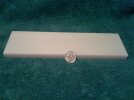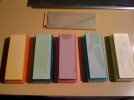I recently ordered a 12 x 3 x 3/4" hard Arkansas from an Amazon vendor. When the box arrived I ripped it open, and immediately noticed "This hard Ark is black!". Checked the box and sure enough, instead of the hard Ark ($92) they had sent a hard black Ark ($240).
I will confess that I struggled with this for a week or so. Finally I said to myself "If you are having to wrestle with what to do next, your choice should be clear, you ^%#&*&^ $%&*##!!!"
As De Niro said in Ronin, "If there is a doubt, then there is no doubt."
So I e:mailed the vendor and told them what had happened, and suggested that I would be happy to call it even, if that was okay with them.
They immediately mailed back telling me to keep the black Ark, and thanking me for being honest. Nice folks!
Problem is, I've been rubbing this baby on a Grizzly "B" surface plate covered with 80 grit AO paper, and it is a long way from true, and I am getting tired. I ordered up some 80 and 120 grit silicon carbide powder and a tile rubbing block, but I'm thinking there must be a better way.
Does anyone have any suggestions on how to move this process along? I've got a 9 x 12 surface plate and a 4 x 36 belt sander but I don't want to wreck this stone. Should I be looking for a machine shop or a place that makes gravestones?
Please help me. I feel like a cave man over here.
I will confess that I struggled with this for a week or so. Finally I said to myself "If you are having to wrestle with what to do next, your choice should be clear, you ^%#&*&^ $%&*##!!!"
As De Niro said in Ronin, "If there is a doubt, then there is no doubt."
So I e:mailed the vendor and told them what had happened, and suggested that I would be happy to call it even, if that was okay with them.
They immediately mailed back telling me to keep the black Ark, and thanking me for being honest. Nice folks!
Problem is, I've been rubbing this baby on a Grizzly "B" surface plate covered with 80 grit AO paper, and it is a long way from true, and I am getting tired. I ordered up some 80 and 120 grit silicon carbide powder and a tile rubbing block, but I'm thinking there must be a better way.
Does anyone have any suggestions on how to move this process along? I've got a 9 x 12 surface plate and a 4 x 36 belt sander but I don't want to wreck this stone. Should I be looking for a machine shop or a place that makes gravestones?
Please help me. I feel like a cave man over here.
Last edited:









